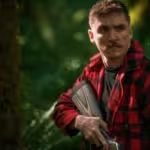Vampires tread a world between extremes. So full of life, but surrounded by death. They are the ultimate consumers, perfectly placed to spend eons accruing wealth, luxury, property, knowledge, and taste, yet doomed to spend eternity starved of pleasures like food and wine and love. Eternally hungry. Eternally horny. Sometimes monstrous. Often Gorgeous.
Its a tough life.
1971’s The Velvet Vampire offers up a unique vision in the pantheon of vampire films. Directed by Stephanie Rothman and produced by Roger Corman via New World Pictures, The Velvet Vampire delivers a stylish, sometimes trippy, and often thoughtful entry to the genre. Rothman takes the, typically male, hungry horror of the vampire and twists it with a liberated 60s sex-appeal without ever diving full force into Euro-Gothic lesbian sexploitation.
Diane LeFanu (Celeste Yarnall) is a stylish affluent vampire, introduced murdering her would-be rapist on a dark city street before calmy cleaning his own knife in a nearby fountain. ‘Evil-Hearted Woman’ a pristinely placed bit of sultry Jazz penned by Johnny Shines then plays as she makes her way to a late-night exhibit at the Stoker Gallery. There Diane toys with a coy role-playing hipster couple, invites them to her house, and from there things get weird.

Rothman’s creature of the night is a far cry from the seductive foreigner of Bela Lugosi, or the towering gentlemanly terror of Christopher Lee, and he doesn’t quite fit in with horny lesbian vampires like Soledad Miranda’s in Vampyros Lesbos. The Velvet Vampire if anything feels like a precursor to Miriam Blaylock, Catherine Deneuve’s gorgeous man-collecting immortal in The Hunger. Her thirst for young couples is as much to do with the search for companionship as it is with the fun of sex and corruption.
She’s a desert-dwelling fashionista who tears across the sun-scorched California sands in a dune buggy. Her evenings are spent frequenting late-night galleries in the city or luring hipster couples back to her hacienda-style home where she lives the single life with a dedicated man servant. Her husband has long (long, long) since perished and the tale of his demise brings her sympathy from young lovers who fall into her grasp.
Diane LeFanu is less the feral ghoul, more the femme-fatale flaneur. She likes art, raw meat, lazing in a crimson kaftan, and rescuing promising young women from their hapless husbands. She’s less cursed, more blessed and she cuts a mean silhouette through the 60s and 70s vampire repertoire. She is a perfect distillation of the alure of a vampire: hedonism and horror, in a film which straddles the boundary between art and exploitation.
The Velvet Vampire is in this way one of the more intriguing 70s vampire films in the way it actually reacts to the liberative forces of the 60s and not just the shifting tides of horror iconography. It’s not enough to just swap a man for a woman, a horse-drawn carriage for a dune buggy, the dark ominous woods of Transylvania for the desert of California. Rothman has some ideas about where the 21st century vampire fits in with the cultural shift in ideas towards women’s empowerment and sexual freedom.
The Velvet Vampire is every bit an ideological reaction to the summer of love as it is the commercial popularity of vampires on screen. Rothman sees the potential for a transformation of the monster away from cursed Gothic isolation and towards the 21st century where indulgence can run amok without the limitations of the classic vampire.
Which is probably why it didn’t fare well at the box office. One thing that strikes hard with Rothman’s film is its resistance to any one particular vampire style. It’s not horny enough to be a lewd exploitation film, not dark enough to be an out-and-out horror, it doesn’t have the draw of a big name, and its art house elements are gorgeous but perhaps not quite what horny young drive-in teens were looking for.
LeFanu is a voyeur, sure, and she’s eroticically charged too, but it’s always presented in a deeply sensual way. There are flurries of trippy imagery, as Diane insinuates herself into the young couples’ dreams, but these never lead to a carnal fuckfest, instead conjuring manipulative moments of seduction. They’re actually quite stunning sequences, and testament to Rothman’s cult vision.
She executes the whole alluring affair in her own unique way, flirting with genre expectaions and audience needs at every turn. Its totally worth seeking out and hopefully a higher quality version will become more readily available soon since the copy currently on Prime is serviceable at best. Its a rare thing when a film lives up to the hype of a title as seductive and evocative as The Velvet Vampire, but here we are.
Dir. Stephanie Rothman
Stars. Celeste Yarnall, Michael Blodgett, Sherry E. DeBoer, Gene Shane, Jerry Daniels,




